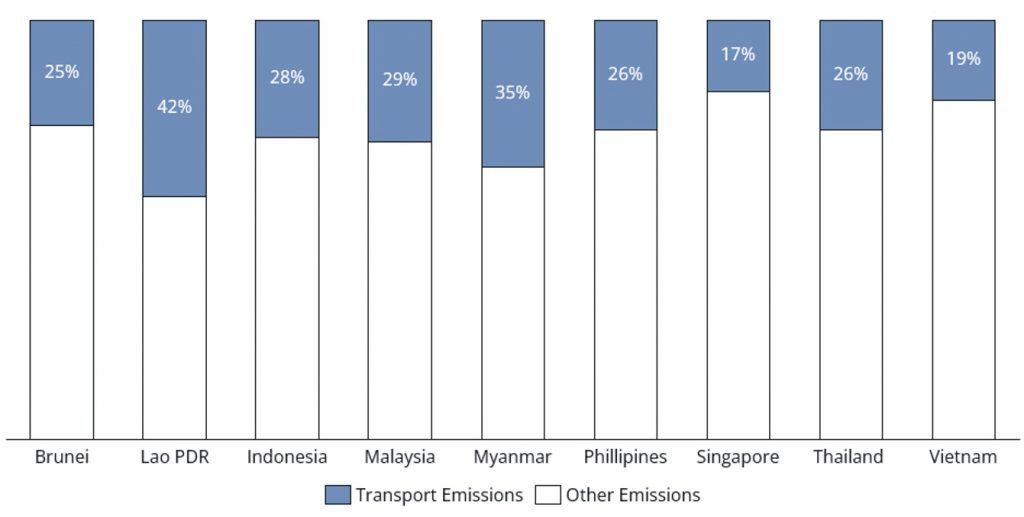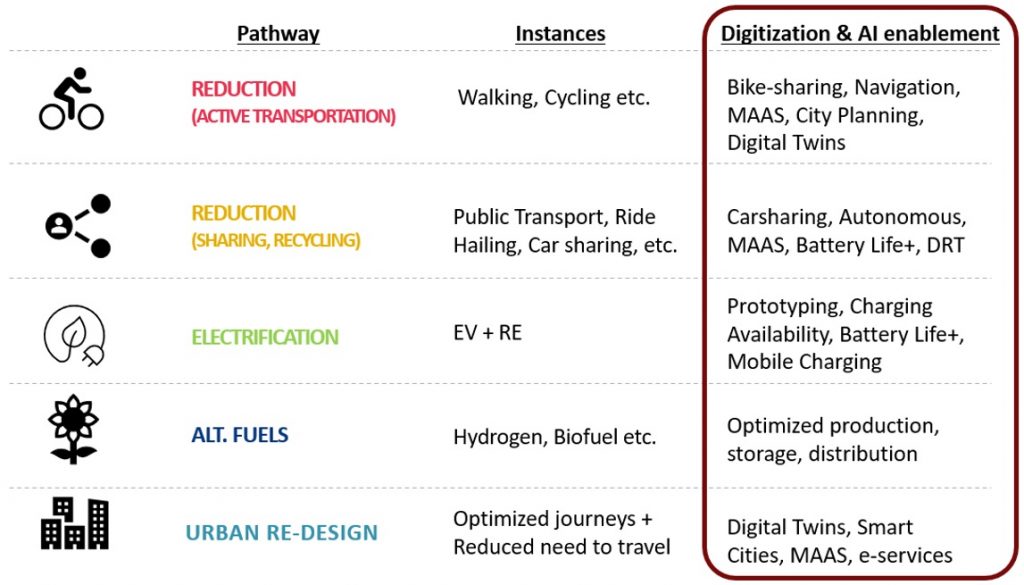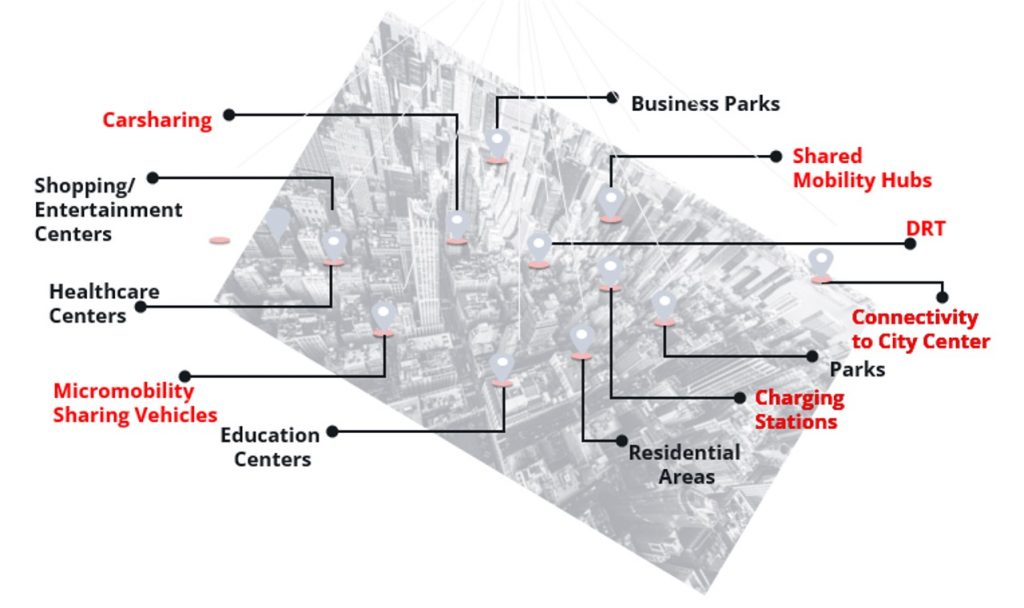



However, this economic reliance on land transport comes at a steep environmental cost. According to the International Energy Agency (IEA), the transport sector accounts for approximately 30% of energy-related CO₂ emissions across Southeast Asia, with road vehicles responsible for nearly 90% of these emissions. This makes road transport not only a source of economic strength but also a primary contributor to the region’s carbon footprint.[1]
As ASEAN nations race toward their net-zero targets, one reality stands out: decarbonizing the transport sector is not just an environmental imperative – it’s a societal one. Road transport alone contributes disproportionately to national emissions. In 2023, the share of road transport in total greenhouse gas emissions ranged from 17% in Singapore to a staggering 42% in Lao PDR, with major economies such as Indonesia (28%), Malaysia (29%), Thailand (26%) and Philippines (26%) also bear a significant transport-driven emissions load.[1] This clearly signals that decarbonizing urban mobility must be a frontline priority – not a secondary concern.

Figure 1: Road Transport Emissions as share of total emissions in ASEAN 2023 [1]
But the case for transport decarbonization extends far beyond carbon reduction. It is also about saving lives. High concentrations of PM2.5 – a fine particulate pollutant largely caused by vehicle emissions – have silently reduced life expectancy across Southeast Asia. By permanently lowering PM2.5 levels from 2021 concentrations to the World Health Organization’s recommended guideline, countries can achieve extraordinary health gains. In Myanmar, such a reduction could increase life expectancy by 3 to 5 years. In parts of Laos and Thailand, a 2 to 3-year gain is possible. Decarbonizing transport is thus not only a climate mandate but also a public health intervention with tangible, measurable outcomes.[2]
To build truly sustainable transport ecosystems, ASEAN cities must pursue a multi-pronged strategy. There are five key pathways to urban transport decarbonization – each uniquely empowered by AI and digital technologies:
| 1. | Reduction through Active Mobility |
| Walking, cycling, and other active modes form the foundation of green mobility. Digital tools such as bike-sharing platforms, smart navigation, Mobility-as-a-Service (MaaS), and city planning through digital twins amplify this shift. | |
| 2. | Reduction through Sharing and Circularity |
| Public transport, ride-hailing, and car-sharing become more efficient when optimized via autonomous systems, demand prediction, and integrated digital platforms for shared mobility. | |
| 3. | Electrification |
| EV adoption must be supported by AI-enabled charging infrastructure, battery management, and mobile charging solutions to ensure scalability and convenience. | |
| 4. | Alternative Fuels |
| Hydrogen and biofuel systems benefit from AI’s ability to optimize production, storage, and distribution – making alternative fuels commercially and operationally viable. | |
| 5. | Urban Re-design |
| Reducing the need to travel by rethinking city layouts – with the help of digital twins, smart city tools, and e-services – can dramatically shrink transport emissions. |

Figure 2: AI-enabled pathways to decarbonize urban transport
While the five pathways provide clear directions, real progress demands convergence – a seamless integration of multiple technologies, platforms, and data ecosystems. This is where AI and digital technologies become the unifying force.
Modern sustainable transport solutions rely on a complex interplay between:
| 1. | Future mobility technologies such as multimodal autonomous fleet management, augmented/virtual reality (AR/VR), and metaverse-based modeling |
| 2. | Smart city platforms that include traffic control centers, AI-powered analytics, geospatial and IoT systems, and curbside management |
| 3. | Connected mobility solutions, such as cloud-based data sharing, open APIs, real-time traffic monitoring, and integrated MaaS platforms |
| 4. | Independent mobility infrastructure, including smart charging, predictive maintenance systems, fleet optimization tools, and dispatch algorithms |
The convergence of these systems shifts urban transport from fragmented legacy operations toward a cohesive, intelligent network. It enables cities to predict congestion, optimize routes, personalize commuter experiences, and dynamically respond to shifting demand – all in real time. More importantly, it supports resource-efficient urban design, where AI informs everything from investment planning to energy use to spatial zoning.
One of the most promising urban planning frameworks for sustainable, inclusive cities is the “15-minute city”[3] – a concept where residents can access work, education, healthcare, retail, and recreation within a 15-minute walk or ride from their homes. Cities like Paris and Melbourne are leading this transition, while Singapore and Dubai are beginning to adapt the model to their own urban realities.
What makes this model viable in dense, fast-growing ASEAN cities is the integration of AI and digital technologies, which serve as essential enablers at every stage of implementation.
| 1. | Smarter city planning |
| Digital tools help urban planners analyze real-time transport trends, commuting patterns, and land-use parameters to optimize where services, amenities, and transport infrastructure should be located. Digital twins – virtual replicas of urban environments – allow simulations that improve decision-making and planning precision | |
| 2. | Connected mobility infrastructure |
| AI and IoT technologies enable demand-responsive transport (DRT) systems, allowing users to efficiently access shared mobility services (like EV buggies or micro transit) efficiently based on live demand. Dynamic pricing algorithms optimize fares according to time, location, and congestion, enhancing system efficiency and revenue potential | |
| 3. | Public-private monetization models |
| With increased digital control over streets and transport access points, cities can generate revenue through curbside monetization – charging logistics providers, delivery vehicles, or ride-hailing services for prioritized access or parking. These mechanisms not only help regulate urban space usage but also unlock new sources of municipal finance to fund sustainable infrastructure | |
| 4. | Equity and access |
| Digital systems can also ensure that mobility is inclusive, addressing the needs of children, the elderly, and disadvantaged communities |
In essence, the 15-minute city is more than just a walkable neighborhood – it’s a digitally intelligent ecosystem, enabled by AI and connected infrastructure, offering cleaner air, reduced travel times, better quality of life, and stronger local economies.

Figure 3: Digital and AI enablement of the 15-minute city
As ASEAN cities transition toward smart mobility, several challenges must be addressed:
| ・ | Technological gaps in localization and cybersecurity |
| ・ | Infrastructure limitations, especially in EV charging and real-time data systems |
| ・ | Policy hurdles, such as outdated licensing frameworks and absent carbon pricing |
| ・ | Cultural resistance to AI and shared mobility |
| ・ | Funding constraints, due to unclear ROI timelines |
| ・ | Fragmented data systems, with poor standardization and reliability |
Addressing these challenges will demand cross-sector collaboration among governments, private players, and advisory firms.
IGPI Singapore has been a trusted partner to mobility players navigating structural transformations, digital disruption, and business model innovation. Our extensive project experience spans:
| ・ | Strategic assessments on the impact of CASE (Connected, Autonomous, Shared, and Electric) on auto manufacturing globally |
| ・ | Go-to-market strategies for battery and EV solutions across Asia |
| ・ | Business model development for digital and financial solutions in mobility |
| ・ | Digital transformation enablement, including driving school modernization and smart fleet management |
| ・ | Investment support, with IGPI-managed funds backing innovative mobility players across India, Japan, and the Nordics |
Our goal is to help clients design sustainable, AI-enabled, and commercially viable mobility strategies tailored to the ASEAN context.
The future of transport in ASEAN isn’t just electric – it’s intelligent. Digital transformation and AI are not mere support functions, they are strategic levers that determine how inclusive, clean, and resilient our cities become.
At IGPI, we believe that rethinking mobility through the lens of digital innovation can unlock economic opportunity, environmental health, and social equity – all at once.
To find out more about how IGPI Group can provide support for businesses, browse through our insight articles or get in contact with us.
[1] EU-ASEAN Business Council (2024): Clean Journeys Ahead – Charting ASEAN’s path towards a decarbonized transport sector
[2] Energy Policy Institute at the University of Chicago. Air Quality Life Index (AQLI)
[3] The 15-Minute City: A Solution to Saving Our Time and Our Planet (by Carlos Moreno, published in 2024)

Kohki Sakata, Partner of IGPI Group & CEO of IGPI Singapore
After joining Cap Gemini and Coca Cola, Kohki joined Revamp Corporation where he managed projects on global expansion and turnaround in various sectors including F&B, healthcare, retail, IT, etc. After joining IGPI, he has managed projects mainly on global expansion and cross border M&A in various sectors such as logistics, IT, telecom, retail, etc. In addition to his broad experience in implementing solutions that has been developed in Western countries, he has developed multiple methods to turnaround Asian companies with focus on setting clear vision and employee empowerment. Kohki has proven the practicality of these methods by turning around Asian companies not only as an advisor but also as senior management.
He graduated from Waseda University Department of Political Science and Economics and IE Business School.

Shivaji Das, Managing Director of IGPI Singapore
Shivaji has over 20 years of strategy consulting experience, specializing in New Business Models, Innovation Roadmaps, and Sustainability Journeys. He has worked with private and public sector clients across 25 countries in sectors like Technology, Semiconductors, Chemicals, Healthcare, Renewable Energy, and Construction. Previously, Shivaji was a Partner and Managing Director-APAC at Frost & Sullivan. His paper on Artificial Intelligence was presented at CAINE-2000 in Hawaii, USA. He is the author of seven acclaimed travel, art and business books including The Visible Invisibles and Rebels, Traitors, Peacemakers (both Penguin Random House), as well as The Great Lockdown: lessons learned during the pandemic from organizations around the world (Wiley, USA).
He is an alumnus of IIT Delhi and IIM Calcutta.

Harsh Munim, Associate of IGPI Singapore
Harsh is a dynamic professional with an MBA from NUS Business School and a BBA in Finance from City University of Hong Kong, where he also had the opportunity to go on an exchange program to Indiana University Bloomington in the United States. With over 4 years of experience, Harsh brings a wealth of expertise to his role at IGPI. Prior to joining IGPI, he worked as a Senior Project Manager at an investment research firm in Hong Kong, where he managed diverse projects in South East Asia and Oceania. During his MBA, Harsh interned with IGPI, contributing to projects related to carbon credits, microgrids, and the consumer goods industry. He also gained valuable experience at IQVIA, where he supported global pharmaceutical companies on LOE strategy, segmentation, targeting, and go-to-market projects.
IGPI Group is a Japan rooted premium management consulting & Investment Group headquartered in Tokyo with a footprint in Osaka, Singapore, Hanoi, Shanghai & Melbourne, as well as parts of Europe and India. The organization was established in 2007 by former members of the Industrial Revitalization Corporation of Japan (IRCJ), a USD 100 billion sovereign wealth fund focusing on turn-around projects in Japan. IGPI Group has 13 institutional investors, including Nomura Holdings, SMBC, KDDI, Recruit & Sumitomo Corporation to name a few. IGPI Group has vast experience in supporting Fortune 500s, Govt. agencies, Universities, SMEs and funded startups across Asia and beyond for their strategic business needs and hands-on support across a wide variety of industries. IGPI group has ~8,500 employees on a consolidated basis.
* This material is intended merely for reference purposes based on our experience and is not intended to be comprehensive and does not constitute as advice. Information contained in this material has been obtained from sources believed to be reliable, but IGPI does not represent or warrant the quality, completeness, and accuracy of such information. All rights reserved by IGPI.